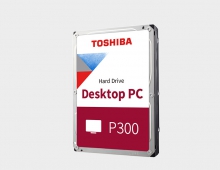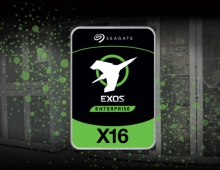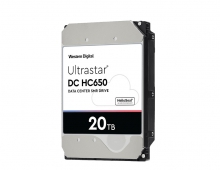
Shingled Magnetic Recording And The Analogy To Flash
Although it looks like the hard disk industry will be moving on to Heat Assisted Magnetic Recording (HAMR), Single Magnetic Recording technology (SMR) is another approach that could increase hard disk storage bit densities, following principles already applied in solid-state drives.
 Shingled Magnetic Recording (SMR) has the potential of increasing track densities by overwriting adjacent tracks like tiles on a roof.
Shingled Magnetic Recording (SMR) has the potential of increasing track densities by overwriting adjacent tracks like tiles on a roof.
As illustrated in the figure on the left, shingled tracks overlap previously written tracks, exploiting the easier task of reading thin tracks than of writing thin tracks.
SMR tracks are written in bands with guard bands in between the bands. This writing technique is projected to increase track densities by 1.5 to 2.5 times. The last track on the band would not be over-written so it could be updated. However, all the over-written bands would require a Read/Modify/Write which could require seconds that would result in timeouts.
"SMR disks will have the 'write once read many' characteristics of tape with the exception that it can be randomly read. Determining the right track requires three revolutions and signal processing in two dimensions," explained Hu Yoshida, Vice President and Chief Technology Officer at Hitachi Data Systems.
Garth Gibson, a professor at Carnegie Mellon University, says that Shingled magnetic recording (SMR) offers fewer technology and manufacturing challenges compared to other technologies for future HDDs, but has a significant impact on the data organization and behavior of data access. Specifically, rewriting a sector on a track that has been shingled over cannot be done without overwriting subsequent tracks. As a result, data on a shingled disk are organized into bands of shingled tracks with a non-shingled guard region between bands. The modification of a portion of a shingled band will require pre-reading and rewriting the modified sectors and all down-band sectors (which will be overwritten as a result of the modification).
So the SMR strategy is imposing restrictions on where data can be written without incurring multi-track 'read-modify-write' penalties.
According to Gibson, these restrictions and penalties can be fully hidden from system software using techniques familiar in NAND Flash disks - designing a controller for SMR to optimize performance and density. In addition, these restrictions can be minimally exposed as multi-track, shingled bands of predetermined size that can be read normally, but only appended to or trimmed (erased).
While these options require significant changes in system software, Gibson believes there is a rich history of demonstrations of log-structured file systems that should be able to do this.
"The systems issues in terms of the interface that such disks should offer is a topic that systems software experts should engage with magnetic disk technologists to decide," Gibson says.
SMR may well be in our future. For more information on SMR, read the Carnegie Mellon technical report on the Principles of Operations for Shingled Disk Devices.
Solid state technologies are expected to eventually replace high performance hard disks, but hard disks will now be able to concentrate on what they do best: provide low cost, high capacity storage.
 Shingled Magnetic Recording (SMR) has the potential of increasing track densities by overwriting adjacent tracks like tiles on a roof.
Shingled Magnetic Recording (SMR) has the potential of increasing track densities by overwriting adjacent tracks like tiles on a roof.
As illustrated in the figure on the left, shingled tracks overlap previously written tracks, exploiting the easier task of reading thin tracks than of writing thin tracks.
SMR tracks are written in bands with guard bands in between the bands. This writing technique is projected to increase track densities by 1.5 to 2.5 times. The last track on the band would not be over-written so it could be updated. However, all the over-written bands would require a Read/Modify/Write which could require seconds that would result in timeouts.
"SMR disks will have the 'write once read many' characteristics of tape with the exception that it can be randomly read. Determining the right track requires three revolutions and signal processing in two dimensions," explained Hu Yoshida, Vice President and Chief Technology Officer at Hitachi Data Systems.
Garth Gibson, a professor at Carnegie Mellon University, says that Shingled magnetic recording (SMR) offers fewer technology and manufacturing challenges compared to other technologies for future HDDs, but has a significant impact on the data organization and behavior of data access. Specifically, rewriting a sector on a track that has been shingled over cannot be done without overwriting subsequent tracks. As a result, data on a shingled disk are organized into bands of shingled tracks with a non-shingled guard region between bands. The modification of a portion of a shingled band will require pre-reading and rewriting the modified sectors and all down-band sectors (which will be overwritten as a result of the modification).
So the SMR strategy is imposing restrictions on where data can be written without incurring multi-track 'read-modify-write' penalties.
According to Gibson, these restrictions and penalties can be fully hidden from system software using techniques familiar in NAND Flash disks - designing a controller for SMR to optimize performance and density. In addition, these restrictions can be minimally exposed as multi-track, shingled bands of predetermined size that can be read normally, but only appended to or trimmed (erased).
While these options require significant changes in system software, Gibson believes there is a rich history of demonstrations of log-structured file systems that should be able to do this.
"The systems issues in terms of the interface that such disks should offer is a topic that systems software experts should engage with magnetic disk technologists to decide," Gibson says.
SMR may well be in our future. For more information on SMR, read the Carnegie Mellon technical report on the Principles of Operations for Shingled Disk Devices.
Solid state technologies are expected to eventually replace high performance hard disks, but hard disks will now be able to concentrate on what they do best: provide low cost, high capacity storage.





















